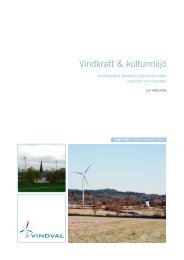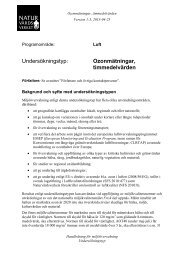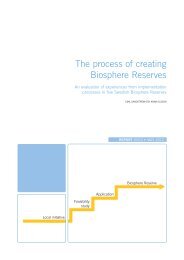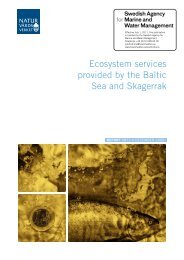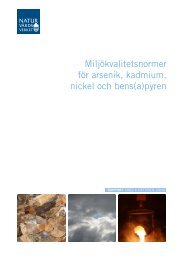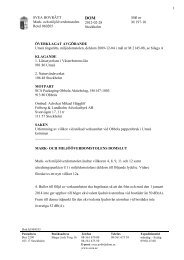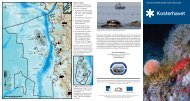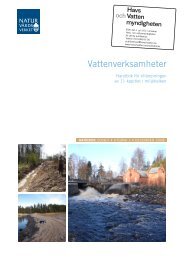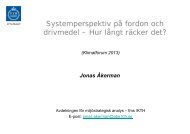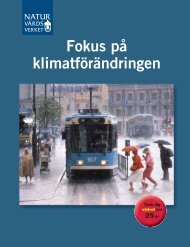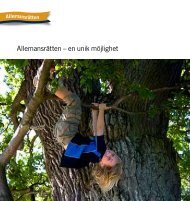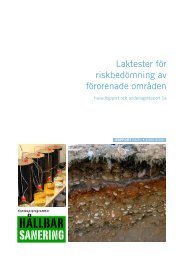Multikriterieanalys (MKA) för hållbar ... - Naturvårdsverket
Multikriterieanalys (MKA) för hållbar ... - Naturvårdsverket
Multikriterieanalys (MKA) för hållbar ... - Naturvårdsverket
You also want an ePaper? Increase the reach of your titles
YUMPU automatically turns print PDFs into web optimized ePapers that Google loves.
HÅLLBAR SANERING<br />
Rapport 5891 – <strong>Multikriterieanalys</strong> (<strong>MKA</strong>) <strong>för</strong> <strong>hållbar</strong> efterbehandling av <strong>för</strong>orenade områden<br />
Summary<br />
Remediation of contaminated land is associated with high costs, both to the<br />
problem owner and to society. In order to manage society’s limited resources,<br />
priority should be given to the remediation alternative that is considered to be<br />
best. A key term in both Swedish and international environmental decisionmaking<br />
is sustainable development. In sustainable development, the economic<br />
aspects constitute an important part, in combination with the ecological and<br />
social-cultural dimensions. By applying the concept of sustainability on<br />
remediation, the resources can be prioritised to the alternatives that are considered<br />
best in the long term.<br />
The economic aspects to society of different remediation alternatives can be<br />
evaluated using Cost-Benefit Analysis (CBA). However, CBA does only consider<br />
one of three dimensions of sustainability. In order to identify sustainable<br />
solutions, the economic dimension must be combined with the ecological and the<br />
social-cultural dimensions of sustainability that cannot be monetised. This can be<br />
achieved by Multi-Criteria Analysis (MCA). MCA has been used as a decision<br />
support tool for many environmental decision problems, including remediation of<br />
contaminated land. The main idea in a MCA is to assess the degree to which a<br />
project fulfils a set of performance criteria. These criteria are evaluated for each<br />
identified decision option, including a baseline alternative. Often, scores and<br />
weights are assigned to each criterion.<br />
The aim of this report is to present a methodology for prioritising between<br />
different remediation alternatives, using a form of Multi-Criteria Analysis (MCA)<br />
based on the sustainability concept. The methodology can be used as a decision<br />
support tool for identifying sustainable remedial actions at contaminated sites.<br />
The MCA methodology that is suggested in this report is based on a linear<br />
additive model (to rank the alternatives) in combination with an outranking<br />
method (to exclude alternatives that are regarded as non-sustainable). Key<br />
performance criteria have been defined so that all three dimensions of<br />
sustainability are covered.<br />
The evaluation of the remediation alternatives takes into account both the<br />
economic, ecological and social-cultural dimensions of sustainability. There is an<br />
extensive scientific discussion about possible and specific definitions of sustainable<br />
development. A distinction can be made between strong and weak sustainability,<br />
as defined by economists. Strong sustainability implies that no form of<br />
capital (natural capital, human capital, man-made capital etc.) is reduced over<br />
time, i.e. compensation between different forms of capital is not allowed. Weak<br />
sustainability on the other hand implies that the sum of all forms of capital does<br />
not decrease over time. Thus, a loss in one form of capital can be compensated by<br />
an increase in another form of capital.<br />
In the suggested methodology, the concepts of strong and weak sustainability<br />
are applied not only to the economic dimension, but also to the performance<br />
criteria in the ecological and social-cultural dimensions. The prime objective is to<br />
identify alternatives that fulfil strong sustainability. If there are no such<br />
9



